Practitioners' Voices in Classical Reception Studies
ISSN 1756-5049
You are here
- Home
- Past Issues
- Issue 3 (2012)
- Marian Maguire
Marian Maguire

Marian Maguire was born in Christchurch, New Zealand, in 1962, and studied at the Ilam School of Art, University of Canterbury and the Tamarind Institute of Lithography, Albuquerque, USA. Alongside making her own work she has pursued a career as a collaborative master printer, in which capacity she has printed the work of some of New Zealand’s leading artists. In 1996 established PaperGraphica, a print studio and gallery which she and fellow artist Nigel Buxton jointly direct. Currently Maguire works almost full-time on her own work. Interview by Jessica Hughes (conducted via email in February 2012). All images copyright of the artist.
- A PDF version of the interview is also available
JH. Classical antiquity has played an important role in your work over the last ten years - but what did your work look like before that? When did you start drawing on classical ideas and objects?
MM. My very early work was gestural and figurative. Then I started drawing gates, archways and bridges as points of transition. That led me to look at the Renaissance and of course I found myself with Greek architecture as a result. Around about 1997–98 I made a set of paintings and prints called Perfect Planning, which combined building plans with statuary and mathematical diagrams, and I was thinking about how things don’t always go as planned. While researching I kept noticing the vases, which I had never much liked – I found them too tight, too stylised, but after a while that is what interested me about them. The tension between the elegance of the stylisation and the earthiness or violence of the subject matter. I started incorporating decorative bands and some figures from the vases into the paintings.
After Perfect Planning I started some images focusing on the tension between elegance and brutishness. This was as a direct result of looking at the vases. I’d been working on plans of temples that were designed around numerical patterns thought to be reflections of universal truths and, in one of the books, I chanced upon a small reproduction of a black-figure vase that showed a scene I couldn’t make out at first. When I looked harder I saw it was a human sacrifice and I was disgusted. (It was the sacrifice of Polyxena on the Tyrrhenian amphora by the Timiades Painter.) What I thought was that stuff like that doesn’t go into pictures unless people actually did it – not just in myth, in actuality. I got to thinking about people owning amphorae like that one with horrendous subject matter, having them around the house, and it was hard for me to reconcile this thought with the notion I’d had of ancient Greek civilisation being a venerable source of Western culture, a guiding influence. (That was before I knew very much about the Greeks.)
Then I thought about the subject matter I might find at the local video shop. One sees exactly the same range in our own culture – from violent, sexual, instinctive reaction at one end to that which is considered, aspirational, refined or poetic at the other. At about this time war was raging in the Balkans. Villages were being raided, men killed, women raped, goods pillaged. I read somewhere that afterwards the victors would drink themselves to oblivion on stolen alcohol. There are a neat few lines in the Odyssey that reflect this type of behaviour:
‘The same wind that wafted me from Ilium brought me to Ismarus, the city of the Cicones. I sacked this place and destroyed its menfolk. The women and the vast plunder that we took from the town we divided so that no one, as far as I could help it, should go short of his proper share. And then I said we must escape with all possible speed. But my fools of men refused. There was plenty of wine, plenty of livestock; and they kept on drinking and butchering sheep and shambling crooked-horned cattle by the shore.’ (chap 9: 39-46, translation E.V. Rieu, Penguin Classics, 1991)
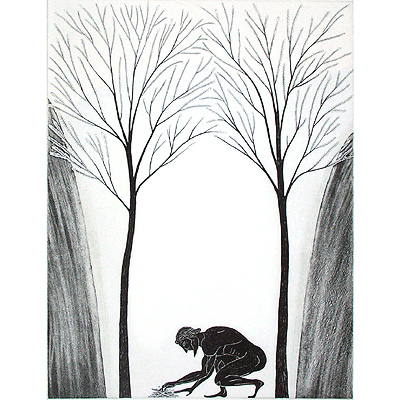
Ajax at Manuka Gully, etching, 2001, 395 x 300mm
My paintings and prints in the late nineties were mostly of figures extracted from vases arranged on abstract fields with other elements. But I found that people didn’t read the narratives. They didn’t see characters, they saw decoration. That was until I included New Zealand trees, then things changed. Once the setting was established it became a real story. This led to a set of etchings from 2002 called Southern Myths in which an adapted and abbreviated Iliad is set in the South Island of New Zealand.
JH. How did you acquire your knowledge of ancient history and myth? Did you study Classics at school or university?
MM. No, I didn’t study Classics. While I was at art school I did the other half of my degree in comparative religions. My knowledge of Classics is patchy and because I am an artist I spend a lot of time looking at pictures. I’ve come to know vase painting reasonably well, although not in an academic sense. I’ve spent time in the British Museum, the Louvre and the Metropolitan Museum of Art in New York. There are also a couple of good collections in New Zealand – it’s always great to see and study the real objects. I read as I feel the need. I have a lot of books. What I read is driven by my curiosity. I’m reasonably familiar with the Odyssey and Iliad, know something of the Olympian myths but little of the plays. My understanding of the ancient history is quite basic.
JH. To some people New Zealand colonial history and ancient Greece might seem like an unlikely pairing. What initially drew you to connect these two cultures?
MM. Yes, I suppose it is an unlikely pairing but at times people also comment that they are surprised no one has done it before. Of course people have drawn the parallel before, right from the time of the voyages of discovery, which coincided with revived interest in classicism. (Sydney Parkinson carried copies of the Odyssey and Iliad with him on Cook’s Endeavour.) I love the Enlightenment Gallery in the British Museum. It’s a neoclassical piece of architecture in which, among other things, items collected from Cook’s voyages are housed almost alongside Etruscan vases.
While making Southern Myths I was wondering whether it was possible or appropriate to impose a layer of myths on a land already laden with myth, in New Zealand’s case the myth of the Maori. I was wondering if myths clash when they occupy the same physical territory, and whether introducing a new story equates to mythical imperialism. Would one supplant the other? I’ve ended up deciding that the myths can all co-exist in the ether – indeed, I’ve come to think it is not healthy for any group of people to cut themselves off from traditions and myths. It just strips people of context. It’s like forgetting your childhood, not knowing your evolution. I have wondered if people can become orphans in a cultural sense.
JH. In your 2005 series The Odyssey of Captain Cook, Cook brought the ancient Greeks to New Zealand. Do the ancient Greeks always stand for European colonisers in your work, or is it more complicated than that?
MM. No, not always. In that series it was more like I included the ancient Greeks alongside the British and Maori. At times they stand in for one group or the other but most of the time the images are triangulated – there is presence of all three parties within the picture. For example in Cook Landing Captain Cook is greeted in Polynesia by a group of Greek Polynesians, and a tattooed Maori man from his first voyage is watching the scene. I think it’s the triangulation that is interesting. It leaves more questions open and keeps things more fluid. There is a fourth group as well – the viewers – who have a perspective that varies according to their background, knowledge and interests.
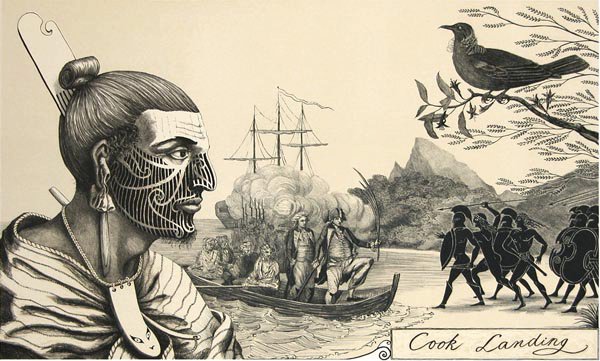
Cook Landing, lithograph, 2003, 362 x 600mm
The Cook series is broadly about first meeting and curiosity. Similarities and differences. The neo-classicism of the eighteenth century made things easy and so did the heroic status of Captain Cook. He becomes more of a symbol than a person in the series. While many of the British aboard the Endeavour saw a link between themselves and the Ancient Greeks there were a lot of possible parallels to draw between the Greeks and Maori in terms of warrior culture, the relationship between people, gods, the land and seasons, and also voyaging. All three groups were expert voyagers.
JH. Your next series focused on Herakles, who was represented as a New Zealand pioneer. What made you pick Herakles as the central figure to use in your exploration of this period of New Zealand’s history?
MM. Having got the Greeks to arrive I decided I needed to face up to what happened next, which was colonisation – the Europeans wrested control of territory and resources from the Maori. It didn’t happen all at once and not all of it was purposeful but that is what happened.
Herakles was the obvious choice for this series. He was such a hard worker, so persistent. Even the title was useful: The LABOURS of Herakles. Herakles offered other advantages. For one thing he is so recognisable with the lion skin and club, he can’t be confused with any other Greek, so visually he could hold the position of a central character who provides continuity through the series. He is also very easy to make fun of because he takes himself so seriously.
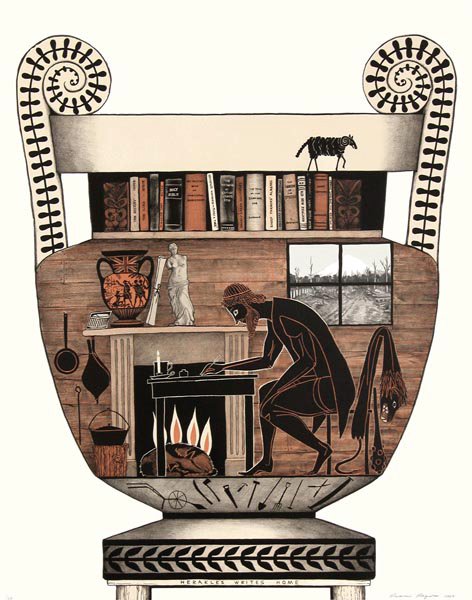
Herakles writes Home, lithograph, 2007, 725 x 570mm
While researching for Herakles I read a lot of New Zealand history, including many first person accounts, and part way through the series I had a shift in thinking as I realised that I had caricatured the early pioneers and they were a lot more varied bunch than I had imagined. Some of them were troubled by what they were doing; they doubted the fairness of it. I therefore gave Herakles doubt, a very un-herculean quality. Once I had given him doubt he stopped being a cartoon figure for me and felt closer to being human.
JH. Your new series Titokowaru’s Dilemma pairs a Maori protagonist, Titokowaru, with the Greek philosopher Socrates. Can you tell us in your own words who Titokowaru was? Why did you choose to base your series around these two figures? Which one came into your mind first?
MM. I chose Titokowaru because I had been looking for a way to make a series about the New Zealand wars, war being the ultimate expression of colonisation by force. What very much appealed to me about him was the tension in him between the warring and the spiritual sides of his character. I also believe he was a very intelligent man, a free thinker, able to get his head around changes in politics, culture and a complete upheaval in world-view.
Titokowaru was a rangitira (chief) and tohunga (priest) with a missionary education. He became a prophet in Pai Marire, a cult that fused traditional Maori religious practices with Christianity. He was also a brilliant military technician. He fought against the British in the wars of the early 1860s. The colonial powers were trying to break up a land block. Under the leadership of a newly established Maori king, some tribes formed an alliance and jointly resolved to sell no more land. This was causing problems for the local administrators as ship after ship was arriving packed with new settlers with nowhere to go – thus the war in the Waikato. Although unable to totally break the King Movement the British won this war and confiscated a great deal of land, much of it in Taranaki, where Titokowaru was from. The confiscations occurred whether the local tribes had been involved in the war or not. Troops were sent in on ‘bush scouring’ missions. This involved raiding peaceful villages, burning the houses, trampling the crops, killing people. The focus on soft targets severely weakened the economic base of Taranaki Maori and caused extreme hardship.
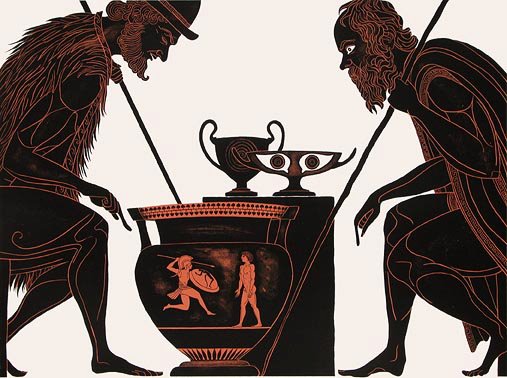
The Dialogue of Titokowaru and Socrates, lithograph, 2010, 570 x 760mm
For a mixture of practical and philosophical reasons Titokowaru elected to live peaceably with the newcomers rather than be continually struggling against them. He thought that co-existence based on mutual respect must be possible. To this end he led a peace march to spread the message and for a short time things were quiet. But as the confiscations were actualised Maori were forced back on to wooded and less cultivatable land and were facing starvation. Titokowaru decided not to allow confiscation beyond a certain point and began a process of passive resistance. The colonisers kept pushing at this boundary, so Titokowaru changed tack and opted for war rather than giving up the remaining cultivatable land.
Being hugely outnumbered and out-gunned his only chance of success was if he tempted the British to attack a prepared position, which he managed to do by what we would now call terror tactics. He was a brilliant strategist and inventive technician and achieved two stunning victories before building an extraordinary pa (fort) only eighteen miles north of the town of Whanganui.
After months of buildup the colonial army approached the pa and camped outside it. In the morning they breached the palisades to find the pa abandoned. Flummoxed, they assumed the Maori had lost heart when confronted by the troops massed for attack. However, Colonel Whitmore, assessing the design and construction of the pa, found that it would have been unassailable and the army would have suffered another massive defeat if the attack had gone ahead. It is unclear why the pa was deserted but Maori sources suggest Titokowaru slept with the wife of an ally the night before the battle and lost his mana (spiritual power) and his authority to command – so Greek!
The disbanding ‘rebels’ were chased back up the coast northward, with rearguard engagements, captained by Titokowaru, being fought en route. Many did not survive the months of pursuit. Somehow, Titokowaru did, and in his later years he was pivotally involved in the events at Parihaka, a spiritual place with a philosophy of peace and a policy of passive resistance to land confiscation. That’s another story.
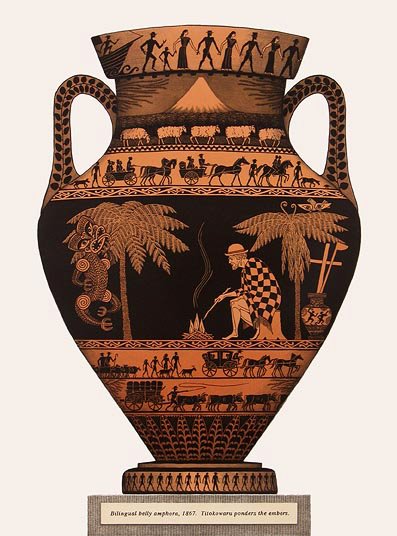
Bilingual Belly Amphora, 1867, Titokowaru Ponders the Embers, lithograph, 2009/10, 765 x 570mm
I think that whatever tactic Titokowaru employed his aim was always to secure a future for his people and I believe him to have been a good man. Albeit flawed.
I can’t remember if I had Titokowaru in mind before I thought of Socrates. The combination came out of a soup.
To me, Socrates embodies the idea of open-minded, rational thinking and he presents ethical challenges. He argues the importance of keeping dialogue fluid, of not jumping to premature conclusions. I find when I talk/think about Socrates it is in the present tense and I suspect this is because I think of him more as an everyday tool than an historical figure. Having said that, there are several appealing parallels between the two men. Socrates was also a soldier, apparently a good one, acknowledged for his valor in the defense of Athens. They were both courageous. But courageous in a completely different way from Homeric characters like Achilles, or Ajax or even Hector. They both risked a great deal on points of principle and were good public speakers, charismatic and, most importantly, capable of thinking outside the square.
Conveniently, they were both supposed to have been quite ugly (Titokowaru’s face was marred by the loss of an eye). While from an ideas point of view this is irrelevant, from a picture-making point of view it is an advantage. I didn’t make them all that ugly in the end, but I was able to give them strong, easily identifiable features that could be recognised from picture to picture.
I realise that the characters of ‘Socrates’ and ‘Titokowaru’, as they exist in my pictures, have shifted somewhat from the historical characters. Without intending to, I’ve ended up altering them to suit the work I have been making and the things I have been thinking about.
JH. A picture like Socrates and Titokowaru discuss the question ‘What is Virtue?’ makes me wish I could eavesdrop on their conversation! What do you think they would have said? Would they have had similar ideas about what virtue constituted?
MM. I think the two of them would have enjoyed talking to each other. They both enjoyed a discussion. Conversing until consensus is reached is the norm in Maori society and Titokowaru was said to have enjoyed conversation.

Socrates and Titokowaru discuss the question, ‘What is Virtue?', lithograph, 2009/10, 407 x 637mm
My understanding is that in Socratic philosophy virtue is defined as knowledge, more or less, and evil as ignorance. Titokowaru may or may not have agreed. For him the pressing question was, ‘What is a virtuous course for a leader to take when invaders are taking the land, poverty is imminent and starvation is likely?’ He must have been plagued by this question before commencing his war, given all the risks a war presents. Socrates was not a leader in this sense and had come to the conclusion that it was impossible to come to a correct decision in politics if that decision could result in harm. Titokowaru did not have the luxury of that position. It’s a really difficult question: What is the right, the best, most virtuous thing to do when there is a threat to survival?
Part of my reason for making this series is that many people would prefer not to think too hard about the impossible situations that colonised people are put into. Even living a few generations down the track it is more comfortable to maintain ignorance than to learn too much about it. But while this is easier, I don’t believe it is virtuous, especially as the effects of the colonial process are still being played out.
JH. I’m interested in exploring the collapse of time and space that is a central feature of your work. For instance, I was very struck by the description in your catalogue essay of how you researched the new series by driving around the battle sites and routes of Titokowaru’s war, listening to Derek Jacobi reading the Iliad and imagining the colonial troops moving through the trails of Taranaki. How do viewers react to seeing different periods and places in one scene? Do you get people asking how on earth the Greeks got there? And how do you think that this ‘time travel’ affects our perceptions of the Greeks and of New Zealand?
MM. Occasionally I do get a double-take from people about the time and space. Or else people at first think the vases, especially those on plinths, are copied from real vases I’ve found in museums somewhere. But after that initial confusion they get the idea that it is all fictitious. In terms of compression of time I think people frequently think of the past as one huge lump, so the distance in time between Captain Cook and Classical Greece may not seem astoundingly greater than the distance between Captain Cook and the present day. They are both a long time ago, especially for children. Children have no concept of the difference between 250 and 2500 years. The other effect of the work is that it puts early New Zealand history into a mythic era, or at least recognises that history can be mythologised. In fact it is always being mythologised. Things that reinforce the dominant culture tend to be remembered, uncomfortable things are forgotten, minimised or sometimes not even recorded. The way history is understood is always with reference to the values and needs of the age it was written in.
I’ve been thinking of the difference between history and myth. There’s a sliding scale. And I don’t think of myths as falsities even if unbelievable. History, as it is recorded, can tell the greater lie because it purports to tell the truth. My own work tells lies, but obvious lies, so no one is duped. I think myths have evolved as a means of interpreting the past and understanding the relationship between culture and environment, or human nature itself.
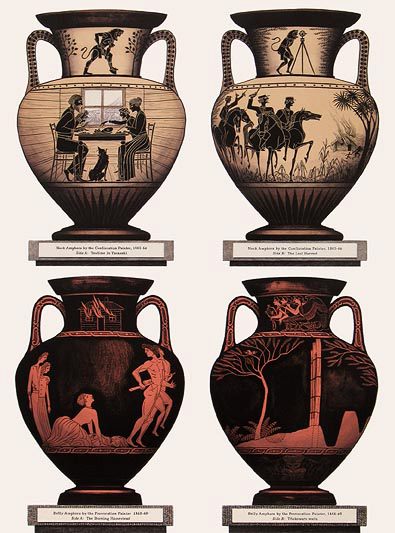
Cause and Effect, lithograph, 2010, 765 x 570mm
In the second part of your question you ask how the ‘time travel’ might affect our perception of the Greeks and New Zealand. I suspect that it makes the Greeks appear like they never really existed except as an idea – they are mostly drawn from the age of myth. Apart from Socrates, there are no historical characters. I’ve only borrowed heroes, supernatural beings or stock figures drawn in a very stylised way.
JH. Now I’d like to ask you specifically about your interaction with Greek vases, which play an important role in your work. What is it about Greek vases that attracts you? Why vases and not, say, sculpture?
MM. A whole pile of things. As I said earlier, I was much more interested in the sculpture at first - it’s so beautiful. But as I have gone further into storytelling the vases interest me more. As well as teaching many lessons about visual narrative, they offer wide-ranging examples of what it is to be human. And they are so quirky, often very funny.
Also, because of the lack of foreshortening the figures are just so odd. So when I include the Greek-style figures in a New Zealand scene they can’t be mistaken for real figures, they just aren’t naturalistic enough, and I can play with juxtaposing them with photographs or paintings from the nineteenth century and the oddness makes the juxtaposition more obvious. It exposes the lie rather than concealing it. Being in profile they look into the picture rather than out of the frame. This works well for my imagery as it leaves the viewer free to watch the action as a voyeur without being challenged or pressured by anyone inside the picture staring back at them. (If someone within the picture were to fix you with their steely gaze, it would feel hard to allow your eye to rove over the rest of the image.)
JH. How do you work with Greek vases in the practical sense? Do you study them in books, or in museum collections? Do you have reproductions in your studio as you work?
MM. I have lots of books with which I am very familiar. And these days, when I find a vase in a book that I want to use I also search for it online, as at times there is a better shot or different angle available on the net. When I first started incorporating the figures I used to copy them with pencil, flattening them as I went. Then I would manually scale them up or down using the grid system – very laborious, but it was good to have done this as I learnt to draw the figures properly using a system. I also came to appreciate how good some of the vase painters were, especially with the entwined figures in which the double form is so lively and complicated, very lovely as an abstract visual and so hard to draw on a curved surface. Lately, I either photograph a figure from a book, use a downloaded one, or draw one from scratch if I can’t find one in the pose I am after. Then I’ll use Photoshop to do the scaling and deal with the curvature. Usually I print this Photoshop sketch out and redraw it before tracing it onto a lithography stone or plate and drawing it properly into the rest of the composition. This is how I approach the bigger figures that I absolutely have to get right. For little, simpler ones I just draw them straight onto the stone or plate.
Aside from the figures I also borrow or adapt decorative bands, foliage and the shapes of the vases themselves, but usually I redraw the vase shape to get it in the proportions I am after to fit the picture.
JH. It seems to me that you engage with the history of the study of Greek vases, as well as their form and iconography. For instance, you play with the question of attribution that has been debated in the scholarship, for instance by attributing some of your vases to artists with names like ‘The Indiscretion Painter’.
MM. I often attribute vases to a fictional artist like ‘The Indiscretion Painter’ in order to get the word ‘indiscretion’ into the image somewhere if it is important to the reading of that narrative. In the image Cause and Effect, which has four vase shapes each with a different scene, I invented amphorae by the Confiscation Painter and the Provocation Painter as the concepts ‘confiscation’ and ‘provocation’ are key elements to understanding the Titokowaru story. The dates for the vases relate to historical time frames and are a nonsense in terms of vase production.
I’m not consistent with my reasoning for using the plinths with invented signage. Sometimes it is to suggest that the story in the vase is of cultural significance and that is why it is sitting as a precious object in a museum. The title gets more kudos, more weight within the image, if it is inscribed on a pretend label in an august font with serifs. At other times I don’t want the title to be so dominant in the image, or may want to reduce the ‘museum’ effect, so I work a simpler title somewhere into the vase or plinth in plain block capitals without serifs.
JH. Are there any modern academic interpretations of Greek vases that you’ve found particularly useful or interesting?
MM. I read Alan Shapiro’s book Myth into Art: Poet and Painter in Classical Greece and it contained two really useful things for me. One is in the first chapter where he is talking about how the vase painters not only bend the imagery around the myth but also warp the myth around the possibilities and limitations of their medium. In other words there is a dynamic between the stories and their visual representation. The artists don’t simply illustrate the stories.
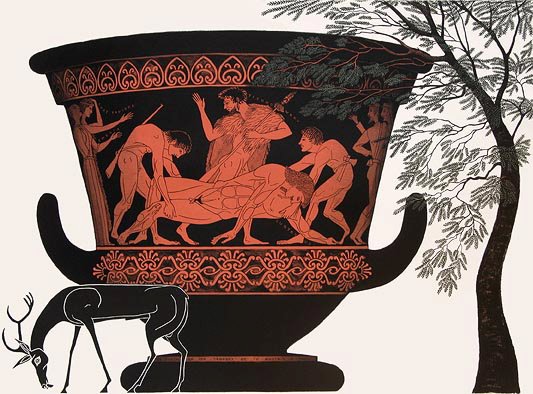
The Death of Von Tempsky at Te Ngutu o Te Manu', lithograph, 2010, 570 x 765mm
The other was a description of the Sarpedon Krater by Euphronios. The way he told the background story influenced my decision to model The Death of Von Tempsky at Te Ngutu o Te Manu on this krater. Shapiro’s writing accentuated the pathos of Zeus’s desire to save the beautiful body of his son from sacrilege, requesting Hermes to summon Sleep and Death to spirit the body from the fields of Troy and return it to his far-distant homeland, where his family could honour him properly by burning his body on a funerary pyre. Shapiro described how Euphronios dealt with this pathos in pictorial terms. I had been thinking how important the theme of The Death of the Hero is in a war epic and within the Titokowaru story there was the perfect example in the demise of Gustavus von Tempsky. He was a Prussian mercenary, a major in the colonial army with film star good looks, a sabre, a white horse, a wife in Auckland and a Maori lover in Taranaki. He had fame throughout the land so it was a huge blow when he was killed and his comrades could not retrieve his body from the battlefield. Many were killed or wounded trying. It was feared that his corpse would be mutilated or cannibalized, but it wasn’t. Titokowaru instructed that von Tempsky’s body should be respected. He was burnt naked on a pyre, honouring his warrior status.
JH. One of the most fascinating things for me about your work is how you create a fictional historical artefact. By this I mean a vase that exists only in the form of a lithograph or etching, but which is treated as though it is a ‘real’ ceramic vase - i.e. by being given a date, a maker, and more generally by being presented according to the conventions of the museum or vase publication. The fictional nature of these artefacts reminds me a little bit of Beauvais Lyons’ work for the Hokes Archives, in which he creates exhibitions about civilizations which don’t actually exist. Lyons has explained his work in terms of forcing people to think more critically about what they are told in museums and other educational contexts. What would you say your own motivations are?
MM. Encouraging people to think more critically about what they are being told by museums, or any institution for that matter, is no doubt a good thing but I am afraid I am less consistent with my reasons for the museum references. For example, in the lithograph Volute Crater 1779, Depicting Scenes from the Odyssey of Captain Cook, which is based on the Francois Vase, I had many aims. One was to give a sense of the era. I also wanted to acknowledge the honour our culture has accorded Captain Cook. I wanted to mythologise and thereby immortalise his story. The image implies untruthfully that he died in New Zealand (not Hawaii), as this makes much more sense from a New Zealand point of view, and the signage gives persuasion to this falsity. Both the signage and the general presentation are very old-fashioned collection-based museum style, very establishment. Other times the plinths give a sense of scale, reality, weight to the vase or I might use them simply to get the vase off the bottom of the paper.
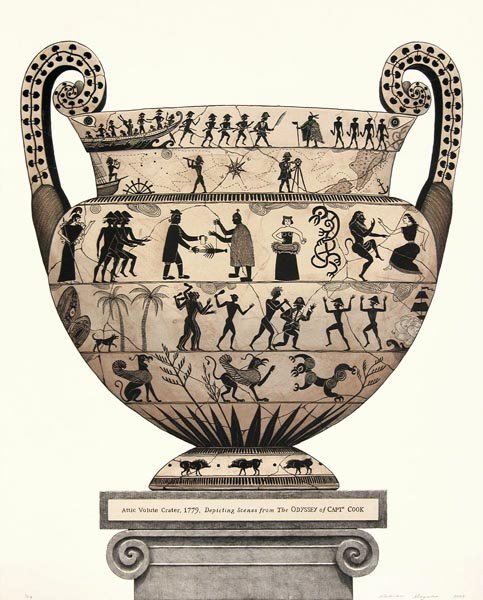
Attic Volute Crater, 1779, Depicting Scenes from the Odyssey of Captain Cook, lithograph, 2005, 700 x 570mm
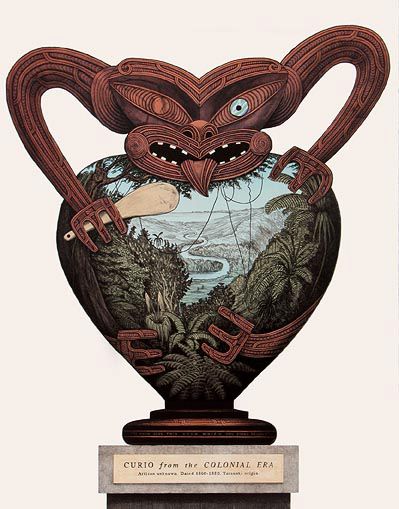
Curio from the Colonial Era: Artisan unknown. Dated 1860-1880. Taranaki origin' lithograph, 2011, 730 x 570mm
In the final lithograph in Titokowaru’s Dilemma I used the museum reference because I hoped to indicate the lack of cultural/historical understanding that has been accorded the Taranaki people. The invented vase is a carved Maori representation of Titokowaru atop, and supplying the arms of, an amphora, inside of which is a verdant image of his world. I called it ‘Curio from the Colonial Era’ and subtitled it ‘Artisan unknown, Dated 1860–1880, Taranaki origin’. This is because Titokowaru was hardly mentioned in the early historical accounts. Only recently has his story been more fully investigated. In small text on the foot of the vase itself (you probably can’t see it in the reproduction) I have quoted from a letter by Titokowaru to the Crown: ‘To whom does this upon which you stand belong?’ Those are important words and I needed to get them into the series somewhere. Perhaps it would be fair to say that I use the titles and signage as a means to get other ideas across that are more easily or elegantly embodied in words than in images.
JH. You have said in the past that that Greek culture (specifically Socrates and the Iliad in relation to Titokowaru) is a “means by which I have better understood my culture and myself.” Looking back on the work that you have produced over the last ten years, what particular insights do you think that ancient Greece has given you, and your viewers?
MM. That’s a big question. Understanding my culture and myself is certainly a work in progress. Through my research into history and myth it is impossible not to find myself moved and challenged. I am often forced to question my preconceptions. The thing that came across for me while working on the recent series and learning about both Socrates and Titokowaru was how important it is to keep thinking – not to close one’s mind. There may be more to a given situation than one knows and, in any case, things are always changing. Life, history, doesn’t stand still. I suppose Greek myth and philosophy give me something to bounce against. I can’t really make assumptions about how people react to the work or what it might stimulate them to think; it would depend on their background knowledge and how curious they are to find out more. I suppose I would hope, however, that the Ancient Greek element would provide another way into thinking about history and the human condition.
JH. Finally, what are your future plans? Can we look forward to more work bringing together New Zealand and Ancient Greece?
MM. More than likely, Jessica, although I’m not sure where I’m going with it precisely. I’m in research phase at the moment.
JH. Well good luck with that, and thank you so much for talking to Practitioners’ Voices about your work!
Find out more...
You can read more about Marian Maguire's work on the following websites:
See also Giovanni Tiso's weblog Bat Bean Beam for articles about The Labours of Herakles and Titikowaru's Dilemma